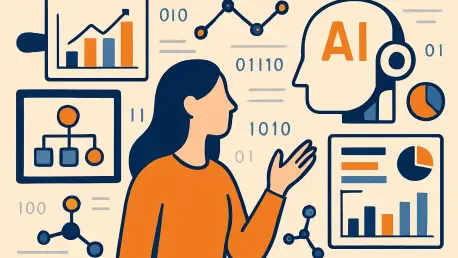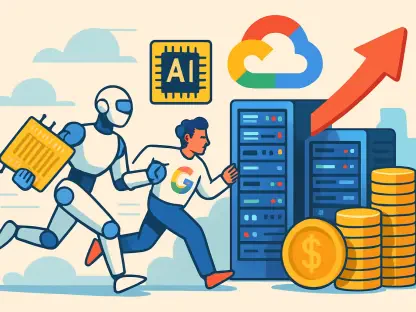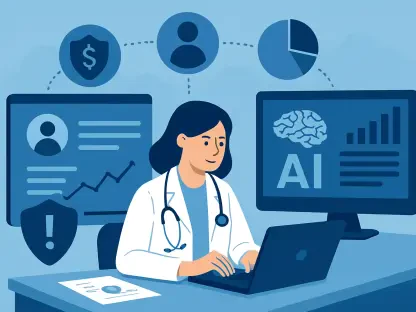Allow me to introduce Chloe Maraina, a visionary in the realm of Business Intelligence with a profound passion for crafting compelling visual stories through big data analysis. With her expertise in data science and a forward-thinking approach to data management and integration, Chloe offers invaluable insights into how artificial intelligence is reshaping the way we work and think. In this engaging conversation, we explore the transformative power of AI, the importance of adopting a growth mindset, the creative potential of AI’s probabilistic nature, and the critical role of human oversight in leveraging these tools effectively. Join us as we dive into the future of technology adoption and data-driven storytelling.
Can you tell us what initially sparked your interest in exploring how AI can transform the way we approach data and problem-solving?
I’ve always been fascinated by how data can tell stories and drive decisions, but it wasn’t until I started working with large datasets in my early career that I saw the limitations of traditional tools. I realized that AI could uncover patterns and insights far beyond human capacity, not just in speed but in creativity. It was a game-changer for me when I first used machine learning to predict customer behavior for a retail project—it felt like I was seeing the future. That experience pushed me to dive deeper into how AI could redefine not just data analysis, but the way we think about solving complex problems.
How do you see the shift from a limiting mindset to a growth mindset playing a crucial role in adopting AI technologies?
A limiting mindset often holds people back because they see AI as a threat or something too complex to grasp. A growth mindset, on the other hand, views AI as an opportunity to learn and improve. I’ve seen this in my own journey—early on, I was intimidated by AI tools, thinking they’d replace my analytical skills. But once I embraced learning how to collaborate with them, I found they amplified my work. This shift is crucial because AI isn’t about replacing us; it’s about elevating what we can achieve if we’re open to adapting.
Reflecting on past technological shifts, can you share a personal story where a tool like Google fundamentally changed how you tackled a challenge?
Absolutely. I remember working on a project about a decade ago where I needed obscure industry data for a presentation. Pre-Google, I would’ve spent hours in a library or bugging colleagues for leads. Instead, I typed a few keywords into Google, and within minutes, I had access to reports and forums I’d never have found otherwise. It shifted my approach from relying on limited personal networks to tapping into a global knowledge base. That moment made me realize how technology could expand my horizons if I embraced it.
Building on that, how do you think the cultural shift to ‘Google it’ has prepared people to embrace AI tools in their daily lives?
The phrase ‘Google it’ normalized the idea of outsourcing curiosity to technology. It got us comfortable with relying on tools to fill knowledge gaps quickly, which is a stepping stone to accepting AI. When people started trusting search engines to provide answers, they began to see tech as a partner rather than a crutch. Now, with AI, it’s an extension of that trust—people are more willing to let AI assist with not just finding information, but also generating ideas or solving problems, because they’ve already adapted to leaning on digital tools.
AI is often described as probabilistic rather than deterministic like a calculator. Can you break down what this difference means for everyday users?
Sure. A deterministic tool like a calculator gives you the same output every time—2 plus 2 is always 4. AI, being probabilistic, works on likelihoods, so if you ask it to write a story or analyze data, you might get slightly different results each time, even with the same input. For everyday users, this means AI can offer fresh perspectives or creative suggestions, like drafting multiple versions of an email. But it also means you can’t always predict the exact outcome, which requires a bit of oversight to ensure relevance.
Speaking of AI’s unique nature, how have you seen its tendency to ‘hallucinate’ or generate unexpected outputs lead to creative breakthroughs?
I’ve had moments where AI’s so-called hallucinations turned into unexpected gold. Once, while using a generative tool to brainstorm marketing taglines for a campaign, it spat out something completely off-base—a metaphor that didn’t fit the product at all. But that odd suggestion sparked a new angle for the campaign that we hadn’t considered. It was like AI threw a curveball that forced me to think outside the box. These quirks can be frustrating, but they often push creativity in ways a rigid tool never could.
How would you address concerns that these unpredictable outputs make AI unreliable for critical tasks?
Those concerns are valid—AI’s unpredictability can be a risk for high-stakes work. My take is that AI should never be a standalone decision-maker in critical scenarios. It’s a powerful assistant, but you need human judgment to filter its outputs. For instance, in data analysis, I always cross-check AI-generated insights against raw data or other sources. The key is to use AI as a starting point or idea generator, not the final word, especially when accuracy is non-negotiable.
You’ve talked about AI elevating performance levels. Can you share a specific example where AI helped someone go from novice to proficient in their work?
I worked with a small business owner who had no background in digital marketing but needed to create social media content. Using an AI tool, they were able to generate post ideas, captions, and even basic graphics tailored to their brand. Within weeks, their engagement rates improved dramatically because the AI helped them mimic the strategies of seasoned marketers. It didn’t make them an expert overnight, but it bridged the gap, giving them the confidence and results to keep learning and refining their approach.
There’s a stigma that using AI feels like cheating. Why do you think this perception exists, and how can it be overcome?
I think this stigma comes from a fear that AI diminishes personal effort or skill. People worry it’s a shortcut that devalues hard work, especially in creative or intellectual fields. To overcome it, we need to reframe AI as a tool, not a replacement. Just as a carpenter isn’t cheating by using a power saw instead of a hand saw, using AI is about efficiency and enhancement. Education helps too—showing people how AI still requires input, critical thinking, and oversight can shift the narrative from cheating to collaborating.
What’s one practical strategy for someone looking to use AI to improve their skills and move to a higher level of task execution?
Start small by identifying a repetitive or time-consuming task in your workflow and see how AI can assist. For example, if you write reports, use an AI tool to draft outlines or suggest key points. Then, focus on refining its output—add your insights, tweak the tone, and verify the facts. This builds a partnership where AI handles the grunt work, and you bring the expertise. Over time, you’ll get faster and more strategic, elevating your overall performance without feeling overwhelmed.
Why is keeping a human in the loop so essential when working with AI, and can you recall a time when this made a significant difference?
Humans in the loop are essential because AI lacks context, ethics, and emotional intelligence. It can crunch numbers or generate content, but it doesn’t understand nuance or consequences like we do. I recall a project where AI analyzed customer feedback for a product launch and flagged certain comments as negative. On paper, the analysis looked accurate, but when I reviewed it, I realized the AI misread sarcasm for criticism. My intervention adjusted the interpretation, which changed how we addressed customer concerns. Without that human oversight, we could’ve made the wrong call.
Looking ahead, what is your forecast for the role of AI in data management and integration over the next decade?
I see AI becoming the backbone of data management and integration, automating complex processes like data cleansing, mapping, and real-time analytics at a scale we can’t imagine today. It’ll likely evolve to predict data quality issues before they arise and suggest governance frameworks tailored to specific industries. But the human element will remain critical—AI will handle the heavy lifting, while we focus on strategy and ethics. I believe we’re heading toward a seamless synergy where AI doesn’t just support but anticipates our data needs, transforming how organizations operate and innovate.









